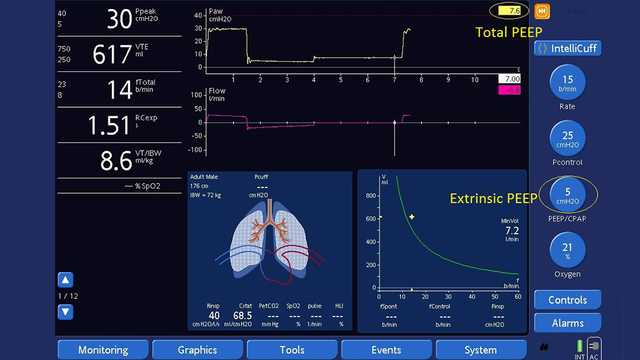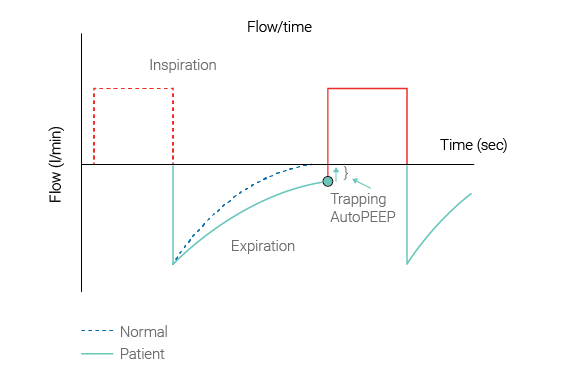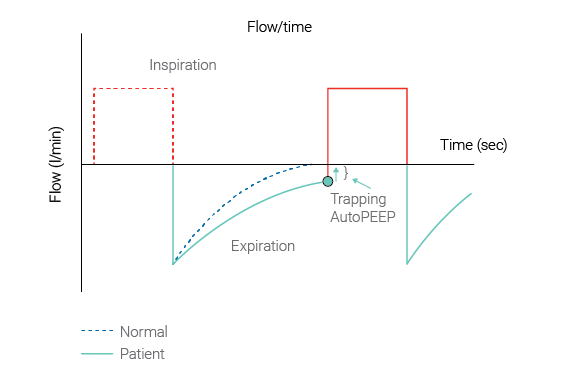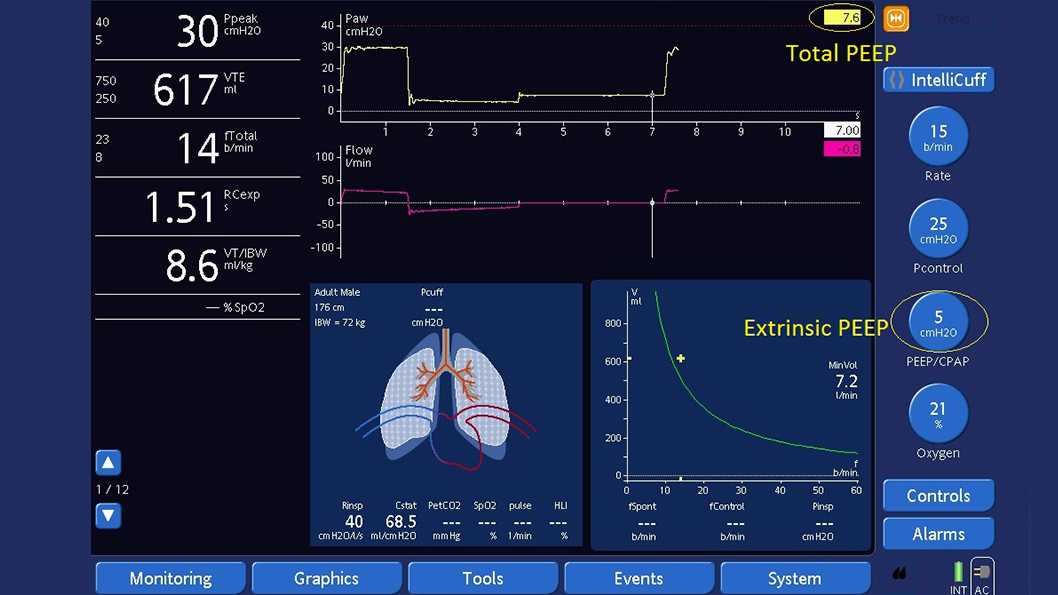
作者: 临床专家组,Hamilton Medical 哈美顿医疗公司
日期: 14.07.2017
Last change: 30.09.2020
(Originally published 14.07.2017) Previously: select Exp hold, when flow=0 select Exp hold again to deactivate hold maneuver. SW versions updated.在存在动态肺过度充气的情况下,肺泡内的平均呼气末压力(即实际的总 PEEP (PEEPtot))高于呼吸机施加的 PEEP (PEEPe)。PEEPtot 和 PEEPe 之间的差异对应于内源性 PEEP (PEEPi),也称为 AutoPEEP (1)。

AutoPEEP 和 RCexp
AutoPEEP 也可称为空气陷闭、呼吸堆积、动态过度充气、意外 PEEP 或隐匿性 PEEP。
AutoPEEP 是具有长呼气时间常数(RCexp)的机械通气病人的常见现象,例如慢性阻塞性肺病或急性严重哮喘病人。
重要事项:在正常呼吸输送过程中,呼吸机的屏幕上显示的气道压力曲线上看不到由此产生的 AutoPEEP。
(下图 1:来自 Garcia Vicente et al。(

AutoPEEP 的影响
AutoPEEP 使病人容易出现呼吸功增加、气压伤、血液动力学不稳定和难以触发呼吸机的情况。未能识别出 AutoPEEP 的血液动力学后果可能导致不适当的液体限制或不必要的升血压治疗。AutoPEEP 可能会影响机械通气撤机。
护理人员应监测通气过程中是否发生 AutoPEEP,并相应地设置其通气控制参数,以避免 AutoPEEP 的负面后果。
测量 AutoPEEP
所有 Hamilton Medical 哈美顿医疗公司呼吸机都具有独特的功能,以逐次呼吸为基础显示 AutoPEEP 作为监测参数。它使用应用于整个呼吸的 LSF 方法计算得出 (
用呼气屏气操作测量总 PEEP(见下图 2):
确保显示气道压力波形。
- 打开屏气窗口。
- 等待,直到气道压力波形图从左侧重新开始。
- 等待下一次吸气。
- 然后选择呼气屏气。等待 3 至 5 秒,然后再次选择呼气屏气或按下按压式旋钮,禁用屏气操作,并关闭窗口。
- 该操作后,“屏气”窗口关闭,并自动激活冷冻功能。
- 通过用游标检查压力曲线上流量达到零后的点,测量总 PEEP。
- 通过从总 PEEP 中减去外源性 PEEP 计算 AutoPEEP。
计算
| AutoPEEP | '= 总 PEEP ‑ 外源性 PEEP = 内源性 PEEP |
|---|---|
| PEEP | '= 外源性 PEEP 且已预选 |
| 总 PEEP | '= 内源性 PEEP + 外源性 PEEP |

避免空气陷闭
如果无意中出现 AutoPEEP,护理人员应考虑调整控制参数,通过增加呼气时间来避免空气陷闭。可能需要使用大直径气管内插管、支气管扩张剂、短吸气时间、长呼气时间、低呼吸频率和使用镇静剂,以避免空气陷闭引起的动态过度充气。
Hamilton Medical 哈美顿医疗公司的所有呼吸机都具有智能通气模式‑适应性支持通气 (ASV®)。ASV 自动采用肺保护策略,以最大程度减少 AutoPEEP 引起的并发症。
相关设备:HAMILTON‑G5/S1 (sw v2.8x and later); HAMILTON‑C3 (sw v2.0.x and later), HAMILTON‑C6 (sw v1.1.x and later)
见下面的完整引文 (
脚注
参考文献
- 1. Iotti, G., & Braschi, A. (1999). Measurements of respiratory mechanics during mechanical ventilation. Rhäzüns, Switzerland: Hamilton Medical Scientific Library.
- 2. García Vicente E, Sandoval Almengor JC, Díaz Caballero LA, Salgado Campo JC. Ventilación mecánica invasiva en EPOC y asma [Invasive mechanical ventilation in COPD and asthma]. Med Intensiva. 2011;35(5):288‑298. doi:10.1016/j.medin.2010.11.004
- 3. Iotti GA, Braschi A, Brunner JX, et al. Respiratory mechanics by least squares fitting in mechanically ventilated patients: applications during paralysis and during pressure support ventilation. Intensive Care Med. 1995;21(5):406‑413. doi:10.1007/BF01707409




